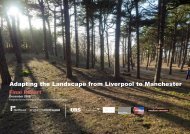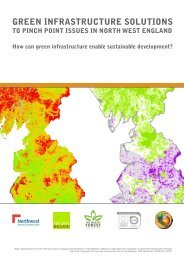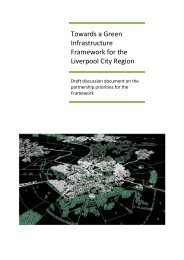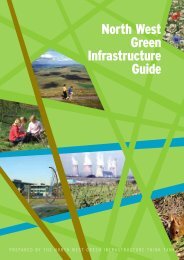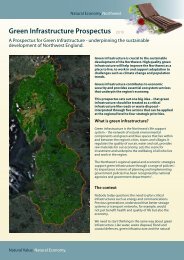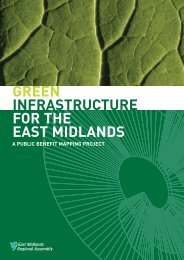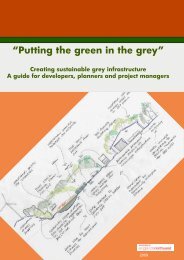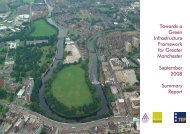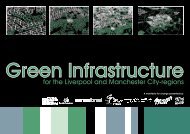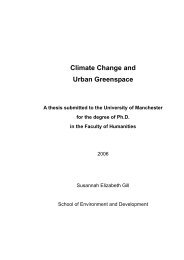The green infrastructure valuation toolkit user guide
The green infrastructure valuation toolkit user guide
The green infrastructure valuation toolkit user guide
You also want an ePaper? Increase the reach of your titles
YUMPU automatically turns print PDFs into web optimized ePapers that Google loves.
Building natural value for sustainable economic development: the <strong>green</strong> <strong>infrastructure</strong> <strong>valuation</strong> <strong>toolkit</strong> <strong>user</strong> <strong>guide</strong><br />
ROPNER PARK, Stockton-on-Tees<br />
“<strong>The</strong> <strong>toolkit</strong> provides some really useful data to demonstrate the<br />
multi-functional nature of the park and its social, environmental and<br />
economic value. For a site like Ropner Park this helps to justify<br />
previous capital investment, and can be used to support the case for<br />
maintaining high-standards of management in the future in order to<br />
maximise the benefits to local people and the Borough as a whole”<br />
Stockton-on-Tees Borough Council<br />
Stockton-on-Tees is one of five boroughs within the Tees Valley in the north-east of<br />
England. It is an area of traditionally heavy industry. Stockton’s population is around<br />
178,000, and that of the wider metropolitan region is around 651,000.<br />
Ropner Park is a Victorian urban park, established in 1893 as Stockton’s principal park.<br />
It covers an area of 15.5ha. <strong>The</strong> park is laid out in a classical style, with grassed<br />
areas, formal bedding, bowling <strong>green</strong>s, a fountain, a bandstand and an ornamental<br />
lake. In 2006 Ropner Park underwent a major refurbishment, with substantial<br />
landscape restoration, construction of a pavilion, tennis courts, a play area and the<br />
installation of an art feature. <strong>The</strong> total cost of this work was nearly £3.5 million, 69% of<br />
which was funded by the Heritage Lottery Fund, with the balance funded by Stocktonon-Tees<br />
Borough Council.<br />
<strong>The</strong> <strong>green</strong> <strong>infrastructure</strong> <strong>valuation</strong> <strong>toolkit</strong> was used to evaluate the benefits of this<br />
significant investment in the park.<br />
Preparation: Understanding physical characteristics and beneficiaries<br />
<strong>The</strong> physical characteristics of the park were analysed to establish the extent of each<br />
<strong>green</strong> <strong>infrastructure</strong> asset, such as area of woodland, rough grassland, lawn and open<br />
water.<br />
<strong>The</strong>n the likely beneficiaries were identified. <strong>The</strong>se were deemed to be visitors to the<br />
park (103,500 per annum) and also the people who live within its range (over 4,500<br />
within 300m and over 22,000 within 1200m) and those businesses which are located<br />
nearby (over 70 within 300m and over 1000 within 1200m).<br />
Assessment: Identifying potential benefit areas and applying relevant tools<br />
<strong>The</strong> next stage was to consider which of the 11 <strong>green</strong> <strong>infrastructure</strong> benefits were likely<br />
to be significant. Parks and formal gardens are likely to have a good climate change<br />
adaptation impact, particularly for temperature regulation. This type of space is also<br />
likely to contribute to quality of place, improved health and well-being, uplift of land and<br />
property value as well as tourism and recreation and leisure. Information on<br />
beneficiaries and maintenance levels (both in terms of density of population and level<br />
of park use) both point to a good likelihood of those benefits occurring.<br />
Looking into the <strong>green</strong> <strong>infrastructure</strong> assets in greater details confirmed this initial<br />
assessment, but it allowed the e<strong>valuation</strong> to be further refined.<br />
<strong>The</strong> relevant tools were applied in order to assess the benefits. <strong>The</strong>se were valued in<br />
monetary terms for those benefits that could be costed, as well as other quantitative<br />
terms and qualitative terms. Some <strong>valuation</strong>s were expressed as a precise figure,<br />
whereas others were expressed as falling within a range of figures. Some benefits<br />
were deemed to last for 20, 30 or even 50 years. In each case, the <strong>valuation</strong>s were<br />
discounted to give a present value (PV) figure, so that benefits which accrued for<br />
different lengths of time could be easily and directly compared.<br />
Reporting: Articulating a strong return on investment case<br />
<strong>The</strong> benefits were calculated as follows:<br />
<br />
<br />
<br />
<br />
Climate change adaptation and mitigation<br />
<strong>The</strong> park, as a large <strong>green</strong> space, has an impact on urban temperatures and<br />
consequently on city liveability. <strong>The</strong> cooling effect was calculated to be 1°C<br />
and this benefited an estimated 2000 households and 74 businesses. This<br />
benefit was not monetised.<br />
<strong>The</strong> value of stored and sequestered carbon in trees and woodland was<br />
calculated to be £30,200 (PV).<br />
Water management and flood alleviation<br />
<strong>The</strong> park provides natural evapo-transpiration of c5iMI of rainfall/annum.<br />
Within an urban context this is a benefit as it reduces volumes entering<br />
combined sewers. <strong>The</strong> value of avoided energy costs and carbon emissions<br />
from the reduced need for water treatment was calculated to be £215,000<br />
(PV).<br />
Health and wellbeing<br />
<strong>The</strong> park provides good opportunities for walking and cycling. Take-up of<br />
such moderate physical exercise helps to reduce mortality rates and this was<br />
calculated at PV of £0.35m over 5 years, £0.65m over 10 years. Annual<br />
mortality reduction benefit was calculated at £75,000 p.a.<br />
Various <strong>green</strong> <strong>infrastructure</strong> elements within the park have an impact on<br />
improving air quality. <strong>The</strong> savings from avoiding other pollution control<br />
measures was calculated to be between £21,000 and £165,000 (PV).<br />
Land and property values<br />
72



